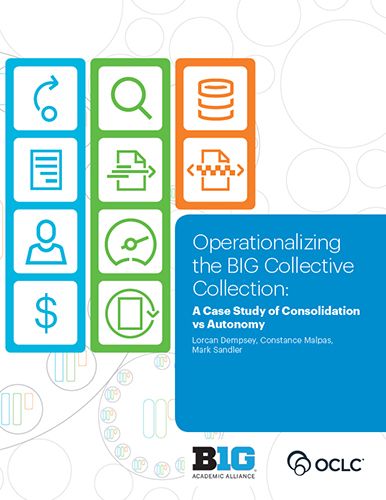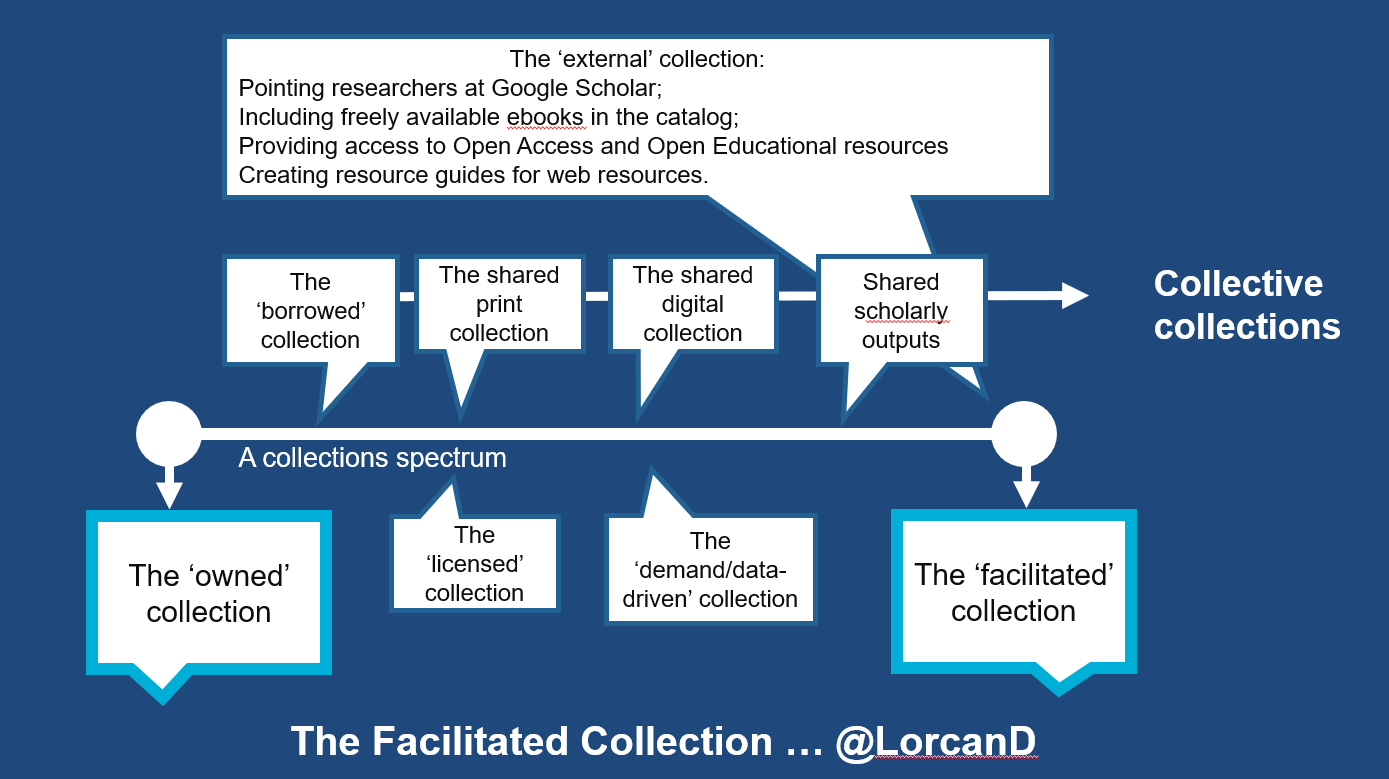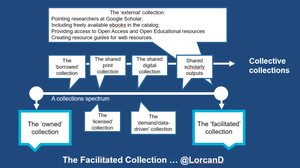In different ways, each moves beyond the carefully constructed and locally acquired collection.
I believe that we will see accelerated broad adoption of these approaches post-pandemic, as collections activity further peels away from the locally acquired collection. In this piece, I speculate about collections in relation to these three directions, and also briefly introduce three additional cross-cutting collection contexts (optimizing, pluralizing and computational reading at scale).
Of course, academic libraries are very focused on the needs of their parent universities or colleges. The pandemic has sharpened discussion about higher education mission and focus. A central consideration for libraries then is the growing importance of the optimised collection. Libraries will increasingly want to optimize their collections against criteria flowing from institutional priorities sharpened by the pandemic response.
This may highlight tensions among the directions I discuss, especially where choices have to be made in an environment of reduced resources. Where a priority is to provide immediate and convenient online curricular support for education, a chosen optimization may be to rely more heavily on vendor offerings, adding ebook collections, streaming services, and other resources. Different choices might be made if one wants to optimize for openness, or for pluralized collections which represent the interests and experiences of local communities. A push to more optimally distribute collections within a consortium means making difficult choices about the locally acquired collections. Does greater investment in inside-out collections - focusing more attention on special collections and scholarly resources which are distinctive to an institution - mean investing less in more commodity resources? Such trade-offs are apparent throughout the discussion below.
Three drivers are important in creating "pandemic effects."
- Libraries will be very focused on campus strategies, as everybody considers priorities, investment, mission. And universities and colleges themselves will be very focused on sharpening priorities.
- The move online has re-patterned behaviors and expectations, which will only partly be reversed. It has accelerated a move already underway, may reveal unmet demand, and will further encourage reexamination of existing practices and investments.
- Libraries will have significant downward pressure on budgets, which will lead to greater optimization, collective action, and a turn to facilitated approaches.
Together, these prompt major rethinking of collections at several levels.
The library identity ... a critical moment for print?
The print collection has been central to the identity, value, and organization of the library. It remains important and its continued stewardship is a responsibility recognized by many libraries.
However, the forced migration online may mark a final transition into a more full digital identity for the library. This is not a simple transition, and telling the library story in this new environment is not straightforward.
It does seem like a moment of real consequence, as decisions which have been quickly taken in recent weeks may determine the dominant ongoing profile of services. While digital library usage may have dominated for some time, and while digital consumes the larger part of academic library budgets, print still looms disproportionately large in terms of identity, organizational structures, and investment of time.
While digital library usage may have dominated for some time, and while digital consumes the larger part of academic library budgets, print still looms disproportionately large in terms of identity, organizational structures, and investment of time.
There will certainly now be pressure to further move resources and people out of acquiring, processing and managing print collections and into other areas. This will encourage a broad move to more collective management of the print collection, as discussed further below. At the same time, the local print collection may become more specialized to local community and regional interests.
The shift also underlines the importance of digital surrogates, as the Internet Archive (not without complaint) and HathiTrust have stepped in to provide substitute services. The role of, and future relationship between, HathiTrust, Jstor, and CRL as stewards of materials digitized by the community becomes a strategic question of some importance for those organizations and for the libraries they serve.
As we move out of crisis mode, we will certainly see a careful reconsideration of controlled digital lending and lobbying around the existing law covering use and reuse of digital materials.
One broad pandemic effect is that a public health dimension will be an important part of all public facilities and services. It will be interesting to see whether health concerns about handling physical materials have any impact on perceptions of print.

The shift towards the collective collection
As we discuss in the BTAA report on operationalizing collective collections, there is always a tradeoff in consortial activity between local autonomy and collective consolidation. This means that a desire for local control often trumps systemwide efficiency. The pandemic will make cooperation a growing necessity across a broader range of library activity, and motivate stronger collective responses. Libraries will need to reconsider what they do locally, focusing where they can create distinctive local impact, and share where it is more efficient.
Libraries license resources at a local and collective level. There is a patchwork of consortia and other agencies who work collectively for libraries in this context. At the same time the licensing environment has become more complex, as multiple paths to open are being pursued, as transformational agreements are being put in place, as the big deal is questioned, and as funder and government mandates are enacted. There is also more opportunity for shared licensing of learning resources, open access discovery aggregations, ebook collections, and so on. What sort of pressure will we see to more strongly coordinate this negotiation landscape? The range of interests is diversifying. The relationship with publishing and publishers is also changing as scholarly communications evolves. Again, different interests may be prioritized depending on institutional priorities. Arrangements are complicated by the mix of research intensity across consortium members, in the context of a shift from pay to read to pay to publish models. Some libraries will be more focused than others on reshaping the scholarly communications landscape.
Collective print collections will assume greater importance, as the economies and efficiencies of shared print management are explored. However, moving to a genuinely collective collection involves clear strategic commitment to shared approaches as well as supporting infrastructure and policy work.
We have made a distinction between retrospective collections coordination and prospective collections coordination.
The former includes resource sharing, shared digitization, and shared print management - layering these approaches over autonomously created collections. The latter includes a more coordinated approach to building and managing collections across a consortium - optimizing at the system level rather than at the individual library level. Such prospective collection coordination would require some move of budget and decision-making to the center. In this model shared print is not a retrospective rationalization of the collective collection, but a formative element of its development.
To be effective, initiatives will really have to begin to take this more holistic view of collecting activities at the network level, and make actual decisions to coordinate more and to move resources into shared activity.
For example, it is widely accepted that prospective collection development makes sense, collaboratively developing collections against a shared need. However, the collective action problem, where decisions continue to be driven by individual local considerations, has dampened developments. Will one pandemic effect be to finally tip libraries into more collaborative approaches to collection coordination, as pressures to optimize investment and collections across consortia grow?
Will one pandemic effect be to finally tip libraries into more collaborative approaches to collection coordination, as pressures to optimize investment and collections across consortia grow?
The shift towards the facilitated collection
We have seen a progressive shift from the locally acquired just-in-case collection to the collection as a service, facilitating access by researchers and learners to resources of potential interest wherever they are.
The goal is to optimally satisfy research and learning needs from a facilitated network of resources (local, collaborative, open, commercial, etc.) rather than to rely only on the careful construction of a locally acquired collection alone. This includes a broad array of services - resource sharing, demand driven acquisition, spot acquisitions, pointing people to a range of freely available resources, more purposefully coordinating access to open resources, and so on.
Several pressures in the current environment encourage this trend, including the budget pressures and the move online. Factors include:
- The move to open. There will be a greater focus on open access resources and open educational resources, for budget reasons but also reflecting general resource trends.
- The need to more directly support curricular needs. The need to support online learning more directly will encourage the facilitated approach, as libraries provide resources tailored to curricular interests.
- A focus on the readily available. An online environment favors the immediately accessible and convenient, wherever it is available.
We also see this trend in the evolution from subject to liaison support, and in the progressive broadening of the ‘literacy’ role - from bibliographic instruction, to digital literacies, to broad consultation around the complexities of the emerging information environment. In each case again, there is a peeling away of support from the local collection to focus more clearly on research and learning behaviors in a broader information environment. A broader critical literacy encompasses thinking about relevant resources, researcher reputation, copyright, publishing choices and OA, data consultancy, and advice around surveillance, algorithmic retrieval, and #fake in a complex evolving environment. These issues have been highlighted in the pandemic context, where science, politics and public policy issues are entwined in intricate ways.

The shift towards the inside out collection
In the sciences, as in other sectors, developments are now jumping over regular process and practices to respond urgently to the new environment, with potential long lasting impact on research culture. The work practices of science are changing and trends accelerating. There is an urgency around greater collaboration (across disciplines, organizations and countries), greater speed in reporting results, and greater use of open channels. There is also some concern about assessing validity and relevance as review processes are compressed or short-circuited. This means that research libraries will more purposefully partner to curate, manage and make more discoverable research outputs like preprints and research data. Research institutions will also be more focused on showcasing expertise and potential contribution through outward facing faculty profiles.
These resources are "inside out" in the sense that there is a strong motivation to share them broadly with those outside the institution. For research libraries, the pandemic strengthens the need to work with faculty and research partners to optimize workflows and support the effective dissemination of research outputs.
Optimizing, pluralizing, and computational reading
In talking to colleagues and in recent presentations, I have become more aware of three cross-cutting emphases in collecting. I was writing about these just as the current situation was breaking and I will return to them in more depth in the future. I thought it useful to record a preliminary note here in the context of the pandemic, especially given the central role of optimization and the growing interest in computational reading.
- Optimizing. Libraries will be very focused on reducing the overall collections spend, because of budget reductions and as they shift resource and attention to diversifying expertise and deepening engagement with their communities. At the same time, local decisions are increasingly being made in the context of collaborative arrangements (as with collective collections) or in the context of what may be sourced elsewhere on the network (facilitated access to open access materials, spot acquisitions, document delivery, and so on). There is a stronger need to target spending (acquire what is needed, use what is acquired), libraries will be more strongly focusing on local curricular, research or community interests, and as noted the pivot to open will be more pronounced. Libraries will be more strongly optimizing collections against particular goals in these ways, and as noted above those goals will now often be shaped by pandemic-influenced institutional priorities. In this way, the differences in how one thinks about collection building in different institutions will be highlighted.
- Pluralizing. Libraries are actively working to pluralize their collections, services and engagement in what will become a more important area of attention. They are thinking about how descriptive practices respect and can express the characteristics and cultural expectations of served communities. They are supporting their communities in creating their own archives or collections. Libraries are also engaging with those communities to better understand values and expectations, and they recognize the need to diversify their own staff and perspectives. More than that, they are recognizing their own entanglements in dominant cultures and institutional settings, and trying to understand where to consciously de-center historically dominant perspectives. Look for example at the initiative to de-center whiteness in Goldsmiths Library, University of London, and the strong focus on recognizing Indigenous peoples in Canadian libraries.
- Computational reading or reading at collection scale. The pandemic has highlighted the need to mine large collections of literature and data, and several initiatives are pulling together research resources for computational analysis. Collections currently serve a close reading model – article by article, chapter by chapter. We have been seeing a growing interest in reading at the scale of a collection, where programs mine collections of data for trends, discovery and insight. This work may now be specialist or boutique, but will become more common for clear reasons. Libraries are providing more support - for example, Boston College Libraries provide several pages of guidance on Text and Data Mining. The pandemic will accelerate this interest.
More than that, they are recognizing their own entanglements in dominant cultures and institutional settings, and trying to understand where to consciously de-center historically dominant perspectives.
Some final notes
There is much to be said about ongoing implications of these collection directions. I note three final ones here.
- A holistic online experience. The circumstances now encourage consideration of a holistic online offering of the library ‘service’, as there is a forced separation from the library as ‘building’ which is still so influential in general perceptions of the value and identify of the library. This means providing richer interactions and experiences in the online setting. Providing convenient and guided experiences across collective, facilitated and locally acquired collections is still a challenge. How do you provide "full library discovery" across the range of resources of potential interest?
- Curation of the scholarly and cultural record is fragmented. Two issues come to mind. As libraries move to more facilitated or collective approaches, the responsibilities towards the scholarly or cultural record become more diffuse. And of course, that record is additionally spread across an extraordinarily complex range of resources: news is generated situationally from databases, large companies stream video and music and have no motivation to preserve what they do, large parts of our cultural memory are created on YouTube or social networking sites and so on. And secondly, especially given increased focus on institutional mission in a time of financial difficulty, fewer libraries may feel a collective responsibility here.
- A moment for consortia. Consortia are an integral part of library operations, and are central to the management of collective collections, licensing and other collections-related activities. Consortia can increase both impact and efficiency of library operations. This seems like a moment for libraries to take a much more strongly strategic view of the collective opportunities available to them, recognising the instrumental value of consortia to advance their goals.
This seems like a moment for libraries to take a much more strongly strategic view of the collective opportunities available to them, recognising the instrumental value of consortia to advance their goals.
We do not know when we will crest the horizon. The pandemic is accelerating some change already underway, forcing strategic reassessments, and underlining the need to focus on institutional needs. Collections will be more collective, facilitated, optimized, and pluralised. Inside out collections and computational reading will become of greater interest. However, not all libraries will be equally interested in all of these directions, especially as they look to sharpened institutional priorities. And trade-offs between the directions (e.g. pluralization vs optimization for value) will be highlighted as decisions are made about resource allocation. As in other areas, pandemic effects are important, evolving and uncertain.
Acknowledgements
Thank you to Constance Malpas and Greg Eow for helpful comments, although of course they are not responsible for how I have used their input. In particular, thanks to Greg for noting how a pandemic effect is to highlight some inherent tension between these directions, something that deserves fuller exploration in the future.
Picture: I took the feature picture in the library at Pepperdine University.
Note: This entry has been cosmetically amended on 27 March 2021 to include feature picture and headings. Blockquotes added 5 November 2022.




